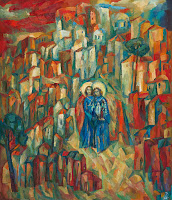I was asked
by the editors of Angelico Press to review a new book The Breviary of Fire, a
compilation of letters by Blessed Mother
Mectilde of the Blessed Sacrament (See Blog April 7, 2017).
The many and often lengthy letters were written to Marie de la Guesle,
the Countess of Chateauvieux, in the
1600s.
Bl. Mectilde was a mystic of the Eucharist like the other
Benedictine mystics, Sts. Mechtilde and Gertrude the Great, as well as St.
Margaret Mary Alacoque in the 17th Century, and into our own day and age, Sts, Faustina and Padre Pio.
In 1654 in Paris she founded the Order of the Benedictine Nuns of Perpetual Adoration of the Blessed Sacrament. This was the first community formally organized for the Perpetual Adoration of the Blessed Sacrament.
I
personally had known of Bl. Mectilde and have often in the past few years
prayed to her. I first encountered her in In SInu Jesu (See Blog 3/25/2-17) , and wondered who this Benedictine nun was whom I had not heard about, and since she plays an important role in this new Benedictine monastery (Silverstream in Meath, Ireland), dedicated to Adoration, I decided I had better check her out.
She seemed to me a very wise, yet down to earth woman taking
much wisdom from St. Benedict and his Rule. She knew many difficulties and sufferings in her own life, and had great compassion as well as an understanding of human nature. Our founding Abbess, Mother Benedict Duss, had many of her qualities and I would call them both "spiritual psychologists".
Bl. Mechtild's letters are for beginners, as well as those already advanced in the spiritual life. She understood the struggle all face at one point or another in their prayer life. She was a true spiritual counselor to the Countess- and to us- as her words are timeless. This is the book one can go to over and over in their own spiritual journey.
Like all great teachers, she is relevant in our modern world in crises. She lived in a century of war, destruction of the sacred and darkness. All that is happening in our world today, from Christians being martyred to Churches being destroyed, proves that society today has more in common with 17th-century France than one might think.
Marie de la Guesle, the Countess of Châteauvieux, met Mother Mectilde of the Blessed Sacrament on a charity visit in August 1651. She was so struck by the Prioress's wisdom, that she returned several days later to resume the conversation. Soon Mother Mectilde became her spiritual directoress, guiding her in her faith, leading her closer and closer to Christ.
The Countess and her husband became great benefactors of Mother Mectilde's newly established order, and on the day after her husband's death in 1662, the Countess entered the convent she had helped to build.
These letters cover a period of about 12 years and later the Countess arranged the nun's letters into a volume which she called her "breviary of fire." Mother Mectilde's nuns passed these letters down through the centuries.This is the first time they are available in English.
The founding Prior, Dom Mark Kirby, of Silverstream, wrote: "Mother Mectilde
offers a vision of Benedictine life capable of rejuvenating monasticism,
especially where it has become institutionalized and listless, with an infusion
of Eucharistic vitality. Her commitment to perpetual adoration of the Most Blessed
Sacrament corresponds to a contemporary yearning, especially among young
people, for a personal, transforming encounter with the Face of God."
According
to Dom Mark Kirby, she
deserves to be universally known in the Church. “She
is a woman of the stature of a Gertrude the Great, of a Teresa of Avila, and of
a Marie de l’Incarnation. Mother Mectilde’s life and mission are a vivid
and compelling demonstration of the role of women in the Church today and in
every age. Her writings, steeped in Sacred Scripture and in the liturgical
tradition that formed her as a Benedictine nun, reveal a woman of profound
human insights and of supernatural wisdom.”This is not a book one picks up and reads in a day or a week, or maybe even a month. It is rather a book to be savored and prayed with. Her letters remind me of another great Benedictine, Dom John Chapman, O.S.B. (d. 1933), who was the 4th abbot of Downside Abbey in England. In his day Dom Chapman was a much sought-after spiritual director and authority on prayer, the spiritual life and mystical theology.
His writings remain of perennial value, especially his Spiritual Letters. An often quoted advice of his was: "Pray as you can, not as you cannot!". These letters are a classic in the Christian contemplative
tradition. A book to read and reread, as his advice is timeless, even thought he wrote in the early part of the 20th century, a hundred years ago.
Just as Dom Chapman stood beside his mentor, Bl. Dom Columba Marmion
O.S.B, ( Abbot of Maredsous -died 1923) whose writings all Benedictines know, now we have a great woman who can stand beside them and needs to be known by all in the monastic spiritual life. Dom Marmion's motto was, "To me, to live is Christ". Bl. Mectilde lived this to the fullest.
" You must take delight in the path in which God has placed you. It is not you who chose it, but eternal Wisdom chose it for you and requires you to give yourself to it without being anxious that you are doing nothing great or excellent for the glory of Our Lord... I confess to you that I have so much respect for His good pleasure that I would prefer to pick up straws from the ground, by His order, than to convert the whole universe by the ardor of my own will". (On Constancy in One's Path)


























